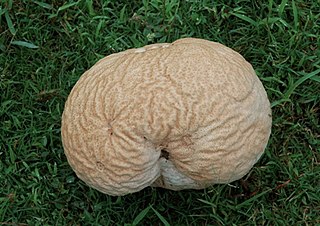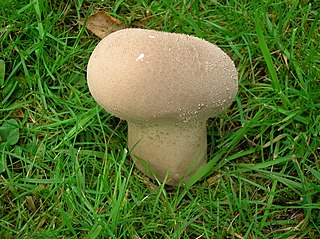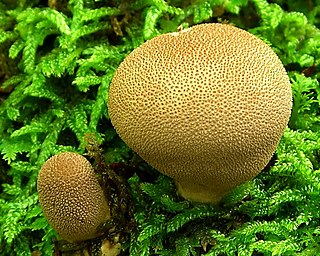
Puffballs are fungi, so named because clouds of brown dust-like spores are emitted when the mature fruitbody bursts or is impacted. Puffballs are in the division Basidiomycota and encompass several genera, including Calvatia, Calbovista and Lycoperdon. True puffballs do not have a visible stalk or stem. The puffballs were previously treated as a taxonomic group called the Gasteromycetes or Gasteromycetidae, but they are now known to be a polyphyletic assemblage.

Lycoperdon is a genus of puffball mushrooms. The genus has a widespread distribution and contains about 50 species. In general, it contains the smaller species such as the pear-shaped puffball and the gem-studded puffball. It was formerly classified within the now-obsolete order Lycoperdales, as the type genus which, following a restructuring of fungal taxonomy brought about by molecular phylogeny, has been split. Lycoperdon is now placed in the family Agaricaceae of the order Agaricales.

Lycoperdon perlatum, popularly known as the common puffball, warted puffball, gem-studded puffball, wolf farts or the devil's snuff-box, is a species of puffball fungus in the family Agaricaceae. A widespread species with a cosmopolitan distribution, it is a medium-sized puffball with a round fruit body tapering to a wide stalk, and dimensions of 1.5 to 6 cm wide by 3 to 10 cm tall. It is off-white with a top covered in short spiny bumps or "jewels", which are easily rubbed off to leave a netlike pattern on the surface. When mature it becomes brown, and a hole in the top opens to release spores in a burst when the body is compressed by touch or falling raindrops.

Calvatia craniiformis, commonly known as the brain puffball or the skull-shaped puffball, is a species of puffball fungus in the family Agaricaceae. It is found in Asia, Australia, and North America, where it grows on the ground in open woods. Its name, derived from the same Latin root as cranium, alludes to its resemblance to an animal's brain. The skull-shaped fruit body is 8–20 cm (3–8 in) broad by 6–20 cm (2–8 in) tall and white to tan. Initially smooth, the skin (peridium) develops wrinkles and folds as it matures, cracking and flaking with age. The peridium eventually sloughs away, exposing a powdery yellow-brown to greenish-yellow spore mass. The puffball is edible when the gleba is still white and firm, before it matures to become yellow-brown and powdery. Mature specimens have been used in the traditional or folk medicines of China, Japan, and the Ojibwe as a hemostatic or wound dressing agent. Several bioactive compounds have been isolated and identified from the brain puffball.

Apioperdon pyriforme commonly known as the pear-shaped puffball or stump puffball, is a saprobic fungus present throughout much of the world. Emerging in autumn, this puffball is common and abundant on decaying logs of both deciduous and coniferous wood. It is considered a choice edible when still immature and the inner flesh is white. It is often called Lycoperdon pyriforme, but was transferred to Apioperdon in 2017 based on phylogenetic and morphological differences. It is the only species in the genus.

Bovista is a genus of fungi commonly known as the true puffballs. It was formerly classified within the now-obsolete order Lycoperdales, which, following a restructuring of fungal taxonomy brought about by molecular phylogeny, has been split; the species of Bovista are now placed in the family Agaricaceae of the order Agaricales. Bovista species have a collectively widespread distribution, and are found largely in temperate regions of the world. Various species have historically been used in homeopathic preparations.

Handkea utriformis, synonymous with Lycoperdon utriforme, Lycoperdon caelatum or Calvatia utriformis, is a species of the puffball family Lycoperdaceae. A rather large mushroom, it may reach dimensions of up to 25 cm (10 in) broad by 20 cm (8 in) tall. It is commonly known as the mosaic puffball, a reference to the polygonal-shaped segments the outer surface of the fruiting body develops as it matures. Widespread in northern temperate zones, it is found frequently on pastures and sandy heaths, and is edible when young. H. utriformis has antibiotic activity against a number of bacteria, and can bioaccumulate the trace metals copper and zinc to relatively high concentrations.

Geastrum corollinum is an inedible species of mushroom belonging to the genus Geastrum, or earthstar fungi. First described scientifically by German naturalist August Johann Georg Karl Batsch in 1792 as Lycoperdon corollinum, it was transferred to the genus Geastrum by László Hollós in 1904.

Lycoperdon echinatum, commonly known as the spiny puffball or the spring puffball, is a type of puffball mushroom in the family Agaricaceae. The saprobic species has been found in Africa, Europe, Central America, and North America, where it grows on soil in deciduous woods, glades, and pastures. It has been proposed that North American specimens be considered a separate species, Lycoperdon americanum, but this suggestion has not been followed by most authors. Molecular analysis indicates that L. echinatum is closely related to the puffball genus Handkea.

Lycoperdon pulcherrimum is a type of puffball mushroom in the genus Lycoperdon. It was first described scientifically in 1873 by Miles Joseph Berkeley and Moses Ashley Curtis. The fungus is found in the southern United States.
Lycoperdon radicatum is a species of puffball mushroom in the family Agaricaceae. It was described in 1848 by French botanists Michel Charles Durieu de Maisonneuve and Camille Montagne. It is nonpoisonous.

Lycoperdon curtisii is a type of puffball mushroom in the genus Lycoperdon. It was first described scientifically in 1859 by Miles Joseph Berkeley. Vascellum curtisii, published by Hanns Kreisel in 1963, is a synonym. Its fruit bodies (puffballs) have been recorded growing in fairy rings. It is nonpoisonous.

Lycoperdon molle, commonly known as the smooth puffball or the soft puffball, is a type of puffball mushroom in the genus Lycoperdon. It was first described scientifically in 1799 by Dutch mycologist Christiaan Hendrik Persoon. The puffball is edible when the internal flesh is still white.

Lycoperdon nigrescens, with the synonym Lycoperdon foetidum, commonly known as the dusky puffball, is a type of puffball mushroom in the genus Lycoperdon. It was first described scientifically in 1794 by the Swedish naturalist Göran Wahlenberg. Visually similar to other species when young, it grows increasingly darker with age, and lacks the pronounced stipe that old Lycoperdon perlatum attain.

Handkea excipuliformis, commonly known as the pestle puffball or long-stemmed puffball, is a species of the family Agaricaceae. A rather large puffball, it may reach dimensions of up to 15 cm (5.9 in) broad by 25 cm (9.8 in) tall. Widespread in northern temperate zones, it is found frequently on pastures and sandy heaths.

Lycoperdon marginatum, commonly known as the peeling puffball, is a type of puffball mushroom in the genus Lycoperdon. A common species, it is found in Europe and North America, where it grows on the ground. It is characterized by the way that the spiny outer layer peels off in sheets.

Scleroderma verrucosum is a basidiomycete fungus and a member of the genus Scleroderma, or "earth balls". First described scientifically in 1791, the species has a cosmopolitan distribution, and grows in the ground in nutrient-rich, sandy soils.

Lycoperdon subincarnatum is a type of puffball mushroom in the genus Lycoperdon. It was first officially described in 1872 by American mycologist Charles Horton Peck. The puffball is found in North America and China.

Lycoperdon lividum, commonly known as the grassland puffball, is a type of puffball mushroom in the genus Lycoperdon. It is found in Europe, where it grows on sandy soil in pastures, dunes, and heaths, especially in coastal areas. It fruits in autumn. It was first described scientifically in 1809 by Christian Hendrik Persoon.

Lycoperdon pratense, commonly known as the meadow puffball, is a type of puffball mushroom in the genus Lycoperdon. It is found in Great Britain and Ireland, including the Outer Hebrides, mainland Europe, and occasionally in North America, and is commonly seen in sand dune systems, where it can be abundant in dune slacks as well as in grassland and lawns, as its vernacular name suggests. In the early stages of development its skin is scruffy whereas its bigger relatives have smooth skins; the meadow puffball is edible and has a stump-like stem.


















